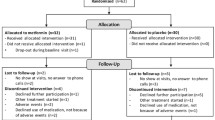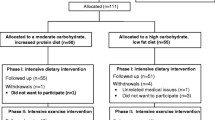Abstract
This study assessed the efficacy of adding metformin to a structured lifestyle intervention in reducing BMI in obese adolescents with insulin resistance. Obese adolescents (25) aged 10–16 years with a body mass index (BMI) > 95th percentile and insulin resistance (Homeostasis Model Assessment—HOMA) > 3.0 were assessed in a community clinic. A structured lifestyle intervention comprising nutritional and exercise education and motivational support in both individual and group sessions was delivered over 6 months. Subjects were randomized to lifestyle intervention alone or with metformin (1500 g daily). The primary outcome measures were a change in BMI and modification of metabolic risk factors, including insulin resistance, plasma lipids and adipocytokines. Eleven adolescents receiving lifestyle and metformin intervention and 14 receiving lifestyle alone completed the study. BMI decreased by 1.8 kg/m2 with lifestyle and metformin but did not change with lifestyle alone. HOMA was significantly decreased in the lifestyle intervention group, but not following metformin, while the adiponectin/leptin ratio improved significantly in both groups. Dyslipidemic profiles improved most significantly with metformin. We conclude that metformin in combination with a 6-month structured lifestyle intervention is effective in reducing BMI in obese adolescents but did not improve insulin resistance. Lifestyle intervention, with or without metformin, improved metabolic risk factors such as plasma lipids and adipocytokines.


Similar content being viewed by others
References
P.W. Franks, R.L. Hanson, W.C. Knowler et al., Childhood predictors of young—onset type 2 diabetes. Diabetes 56, 2964–2972 (2006)
S.E. Kahn, R.L. Hull, K.M. Utzschneider, Mechanisms linking obesity to insulin resistance and type 2 diabetes. Nature 444, 840–846 (2006)
S. Arslanian, Type 2 diabetes mellitus in children: pathophysiology and risk factors. J. Pediatr. Endocrinol. Metab. 13, 1385–1394 (2000)
M.S. Tremblay, J.D. Willms, Secular trends in the body mass index of Canadian children. Can. Med. Assoc. J. 163, 1429–1433 (2000)
A. Fagot-Campagna, D.J. Pettitt, M.M. Engelgau et al., Type 2 diabetes among North American children and adolescents; an epidemiologic review and a public health perspective. J. Pediatr. 136, 664–672 (2000)
H.J. Dean, R.L. Mundy, M. Moffatt, Non-insulin dependent diabetes mellitus in Indian Children in Manitoba. Can. Med. Assoc. J. 147, 52–57 (1992)
R.Y. Sung, P.C. Tong, C.W. Yu et al., High prevalence of insulin resistance and metabolic syndrome in overweight/obese preadolescent Hong Kong Chinese children aged 9–12 years. Diabetes Care 26, 250–251 (2003)
N. Stefan, J.C. Bunt, A.D. Salbe et al., Plasma adiponectin concentrations in children: relationships with obesity and insulinemia. J. Clin. Endocrinol. Metab. 87, 4652–4656 (2002)
F. Bacha, R. Saad, N. Gungor et al., Adiponectin in youth: relationship to visceral obesity, insulin sensitivity, and beta cell function. Diabetes Care 27, 547–552 (2007)
M. Bajaj, S. Suraamornkul, L.J. Hardies et al., Plasma resistin concentration, hepatic fat content, and hepatic and peripheral insulin resistance in pioglitazone-treated type II diabetic patients. Int. J. Obes. Relat. Metab. Disord. 28, 783–789 (2004)
L. Gilardini, P.G. McTernan, A. Girola et al., Adiponectin is a candidate marker of metabolic syndrome in obese children and adolescents. Atherosclerosis 189, 401–407 (2006)
G.Q. Shaibi, M.L. Cruz, M.J. Weigensberg et al., Adiponectin independently predicts metabolic syndrome in overweight Latino youth. J. Clin. Edocrinol. Metab. 92, 1809–1813 (2007)
M. Savoye, J. Dziura, J. Castle et al., Importance of plasma leptin in predicting future weight gain in obese children: a two-and-a-half-year longitudinal study. Int. J. Obes. Relat. Metab. Disord. 26, 942–946 (2002)
J.P. Kay, R. Alemzadeh, G. Langley et al., Beneficial effects of metformin in normoglycemic morbidly obese adolescents. Metabolism 50, 1457–1461 (2001)
M. Freemark, D. Bursey, The effects of metformin on body mass index and glucose tolerance in obese adolescents with fasting hyperinsulinemia and a family history of type 2 diabetes. Pediatrics 107, E55 (2001)
S. Srinivasan, G.R. Ambler, L.A. Baur et al., Randomized controlled trial of metformin for obesity and insulin resistance in children and adolescents: improvement in body composition and fasting insulin. J. Clin. Endocrinol. Metab. 91, 2074–2080 (2006)
K. Love-Osborne, J. Sheeder, P. Zeitler, Addition of metformin to a lifestyle modification program in adolescents with insulin resistance. J. Pediatr. 152, 817–822 (2008)
R.H. Lustig, M.L. Mietus-Snyder, P. Bacchetti et al., Insulin dynamics predict body mass index and z-score response to insulin suppression or sensitization pharmacotherapy in obese children. Pediatrics 148, 23–29 (2006)
B. Schwartz, D.R. Jacobs, A. Moran et al., Measurement of insulin sensitivity in children: comparison between the euglycemic hyperinsulinemic clamp and surrogate measures. Diabetes Care 31, 783–788 (2008)
S.D. Ferranti, S.K. Osganian, Epidemiology of paediatric metabolic syndrome and type 2 diabetes mellitus. Diabetes Vasc. Dis. Res. 4, 285–296 (2007)
E.S. Kim, J.A. Im, K.C. Kim et al., Improved insulin sensitivity and adiponectin level after exercise training in obese Korean youth. Obesity 15, 3023–3030 (2007)
E.E. Reiterer, K.M. Sudi, A. Mayer et al., Changes in leptin, insulin and body composition in obese children during a weight reduction program. J. Pediatr. Endocrinol. Metab. 12, 853–862 (1999)
V.M. Cambuli, M.C. Musiu, M. Incani et al., Assessment of adiponectin and leptin as biomarkers of positive metabolic outcomes after lifestyle intervention in overweight and obese children. J. Clin. Edocrinol. Metab. 93, 3051–3057 (2008)
M. Zeller, S. Kirk, R. Claytor et al., Predictors of attrition from a pediatric weight management program. J. Pediatr. 144, 466–470 (2004)
K.M. Young, J.J. Northern, K.M. Lister, J.A. Drummond, W.H. O’Brien et al., A meta-analysis of family-behavioural weight-loss treatments for children. Clin. Psychol. Rev. 27, 240–249 (2007)
N. Gungor, R. Saad, J. Janosky et al., Validation of surrogate estimates of insulin sensitivity and insulin secretion in children and adolescents. J. Pediatr. 144, 47–55 (2004)
M. Keskin, S. Kurtoglu, M. Kendirci et al., Homeostasis model assessment is more reliable than the fasting glucose/insulin ratio and quantitative insulin sensitivity check index for assessing insulin resistance among obese children and adolescents. Pediatrics 115, 500–503 (2005)
P. Allard, E.E. Delvin, G. Paradis et al., Distribution of fasting plasma insulin, free fatty acids, and glucose concentrations and of homeostasis model assessment of insulin resistance in a representative sample of Quebec children and adolescents. Clin. Chem. 49, 644–649 (2003)
2005 CDC growth charts for the United States, Methods and development. (2005), www.cdc.gov/nchs/data/series/sr_11/sr11_246.pdf
Acknowledgements
We are grateful to Lynda Bere, Bonnie Hill, Johanna Kaipainen and Ruth Aitchison for clinical and administrative support and Brenda Strutt who provided expert technical assistance. We acknowledge the financial support for this study provided by the Lawson Foundation, the Canadian Institutes of Health Research and the Lawson Health Research Institute.
Author information
Authors and Affiliations
Corresponding author
Additional information
The sponsors had no involvement in the study design, collection, analysis, and interpretation of data; in the writing of the report; and in the decision to submit the paper for publication.
Rights and permissions
About this article
Cite this article
Clarson, C.L., Mahmud, F.H., Baker, J.E. et al. Metformin in combination with structured lifestyle intervention improved body mass index in obese adolescents, but did not improve insulin resistance. Endocr 36, 141–146 (2009). https://doi.org/10.1007/s12020-009-9196-9
Received:
Accepted:
Published:
Issue Date:
DOI: https://doi.org/10.1007/s12020-009-9196-9




